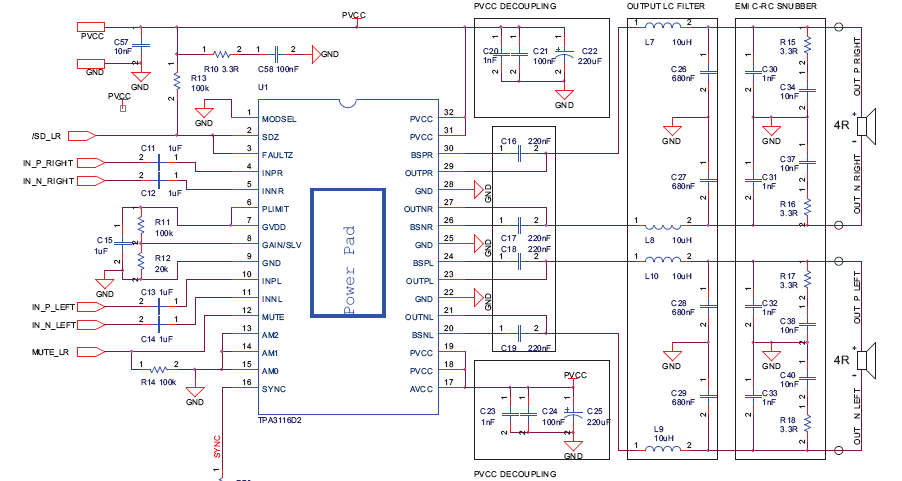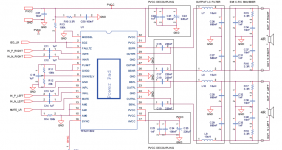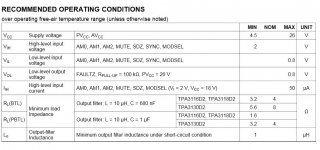Why use 4ohm speakers?Of course not. You're comparing an optimally designed TPA3116 amp to the worst TA2020 amp on the market. There should be no comparison as the exact same things you note is better is the exact same thing a decent quality TA2020 amp also does better than the Lepai.
That being said. I do consider the TPA311x chip better than TA2020. Mind you though that the YangJing amps linked here are far from as well designed as the @BUG. It is for some reason designed for 8-16 ohm, not 4-8 ohm. And will on a normal 4 ohm load perform considerably worse than a (decent) TA2020 amp.
Why use 4ohm speakers?
Typical for portable speakers, either as 4 ohm drivers or as paralleled 8 ohms drivers. And absolute necessity requirement of any amp to be used for portable audio.
What is your "portable audio", I'm guessing it is not personal portable audio?Typical for portable speakers, either as 4 ohm drivers or as paralleled 8 ohms drivers. And absolute necessity requirement of any amp to be used for portable audio.
What is your "portable audio", I'm guessing it is not personal portable audio?
Define personal portable audio.
It's primarily Boominators and Boominator MINIs but also almost all other classic DIY boombox/portable audio builds that this amp is unsuited for because of poor design, not the chip itself.
Last edited:
I'm very happy with the $17 board connected to a pair of very, very good speakers.Define personal portable audio.
It's primarily Boominators and Boominator MINIs but also almost all other classic DIY boombox/portable audio builds that this amp is unsuited for because of poor design, not the chip itself.
Unfortunately most DIYers, being a frugal bunch, prefer to build their own boxes and populate them with whatever is on sale at the time.
Of course I'm not suggesting this applies to you.
Saturnus,
I agree comparing to a Lepai is not fair - but from the standpoint of an equivalent price point circa $20 - it is very pertinent. I am just saying for about the same money, the TPA3116D2 is a better performer and value.
I was unaware that the YJ "red PCB" TPA3116D2 amps are 8 ohm? The chip itself is designed to handle 4 ohms normally if one follows the standard TI reference design (of Fig 27 as used by @DUG). I am not sure which component change makes the YJ board 8 ohms nominal? Is it the switch to 22 uH inductors vs the factory spec'd 10 uH? That affects the mod frequency filtering cut-off.
TI's Ref Design (Fig 27):

Is there any literature or specs from YJ that says these are nominal 8 to 16 ohm loads?
I agree 4 ohm capability is very important as it provides the amp with the max power capability, the distortion figure is lower for the same ps voltage, and lets you run double-up drivers in parallel which I do all the time.
Regards,
X
I agree comparing to a Lepai is not fair - but from the standpoint of an equivalent price point circa $20 - it is very pertinent. I am just saying for about the same money, the TPA3116D2 is a better performer and value.
I was unaware that the YJ "red PCB" TPA3116D2 amps are 8 ohm? The chip itself is designed to handle 4 ohms normally if one follows the standard TI reference design (of Fig 27 as used by @DUG). I am not sure which component change makes the YJ board 8 ohms nominal? Is it the switch to 22 uH inductors vs the factory spec'd 10 uH? That affects the mod frequency filtering cut-off.
TI's Ref Design (Fig 27):

Is there any literature or specs from YJ that says these are nominal 8 to 16 ohm loads?
I agree 4 ohm capability is very important as it provides the amp with the max power capability, the distortion figure is lower for the same ps voltage, and lets you run double-up drivers in parallel which I do all the time.
Regards,
X
Attachments
Last edited:
Saturnus,
I agree comparing to a Lepai is not fair - but from the standpoint of an equivalent price point circa $20 - it is very pertinent. I am just saying for about the same money, the TPA3116D2 is a better performer and value.
I am not sure which component change makes the YJ board 8 ohms nominal? Is it the switch to 22 uH inductors vs the factory spec'd 10 uH? That affects the mod frequency filtering cut-off.
Yup. And the output filter caps aren't 0.68µF either as specified by TI. It's a terrible blunder on YangJing's part to save $0.30 in parts and lose 80% of their potential market. And no, YJ doesn't specify load impedance but we can just calculate that it's designed for 8-16 ohm loads from the spec sheet.
Have to note that you can get decent TA2020 amps for under $20.
Have you actually purchased one of these amps, you appear to be the only critic on this thread?Define personal portable audio.
It's primarily Boominators and Boominator MINIs but also almost all other classic DIY boombox/portable audio builds that this amp is unsuited for because of poor design, not the chip itself.
Good catch Saturnus. Looks like all we need to do is swap out the 22uh for 10 and 680 for 1uf. Should be easy enough. I just got mine and it is driving 4ohm MTMs and still sounds great.
So what inductors are good quality?
Here are the recommended operating conditions (see attachment)
The stock YJ 2.0 board comes with 22uH and .56uF and drove 4 and 8 Ohm speakers without any issues. I've now installed 10uH coils and have experimented with various film caps ranging from .47 - 1uF and again it drove 4-8 Ohm speakers without any issues.
Regardless of what is considered optimum, this stock board should provide decent sound for most speakers that might be used.
Attachments
The roughly 3dB peak at 16khz (slowly rising from roughly 2khz) using a 22mH output inductor will cause can be beneficial to some full-range speakers or tweeters that have a declining output, btw. It's also followed by a higher Q at peak, so expect some extra added sparkle in the highest treble.
Last edited:
The roughly 3dB peak at 16khz (slowly rising from roughly 2khz) using a 22mH output inductor will cause can be beneficial to some full-range speakers or tweeters that have a declining output, btw. It's also followed by a lower Q at peak, so expect some extra added sparkle in the highest treble.
That is very similar what I'm hearing (measurement setup is put away right now) although not objectionable.
So what inductors are good quality?
I'd also like to hear some informed opinions on this too. I plan on ordering another set of inductors to try but am confused by all of the variables and choices.
Also, the output from the chip has 220nf caps in series before the coils.
Does this value need to be changed when changing the value of the inductors?
Oh boy! looks like the thread is going to follow the Lepai tweakathonI'd also like to hear some informed opinions on this too. I plan on ordering another set of inductors to try but am confused by all of the variables and choices.
Also, the output from the chip has 220nf caps in series before the coils.
Does this value need to be changed when changing the value of the inductors?
The 220 nF cap is the bootstrap cap and is not in series with the output but tapped off of it if you look at Fig 27 several posts back. The bootstrap cap provides the switching FET the bias it needs to work and stays fixed at 220 nF independent of the LC filter. I don't know why YJ messed with the LC combo spec. The thing to look for in inductor specs is whether or not the specified nominal inductance value stays constant as a function of current. The cheaper ones will have a reduced inductance as current goes up. The other thing to look for is what the current rating is. For 40 watts driven by 17 volts the peak current is 2.35 amps. This level of current is really only for peaks and transients as we will operate below 25 w most of the time in a continuous mode. Many of the inductors should be rated for at least 2 amps and ideally 3 amps. I know Dug has looked into this extensively and can provide us more tips. You have to look at the manufacturers spec sheets for performance vs current.
The 220 nF cap is the bootstrap cap and is not in series with the output but tapped off of it if you look at Fig 27 several posts back. The bootstrap cap provides the switching FET the bias it needs to work and stays fixed at 220 nF independent of the LC filter. I don't know why YJ messed with the LC combo spec. The thing to look for in inductor specs is whether or not the specified nominal inductance value stays constant as a function of current. The cheaper ones will have a reduced inductance as current goes up. The other thing to look for is what the current rating is. For 40 watts driven by 17 volts the peak current is 2.35 amps. This level of current is really only for peaks and transients as we will operate below 25 w most of the time in a continuous mode. Many of the inductors should be rated for at least 2 amps and ideally 3 amps. I know Dug has looked into this extensively and can provide us more tips. You have to look at the manufacturers spec sheets for performance vs current.
Excellent information. Thanks for the clarification. This should help a lot.
I just ordered the wurth inductors sendler praised for the tk2020/2050 from mouser. They are probably too big to fit but I'll figure something out.
I also ordered a second board from Aliexpress (although 'along' on ebay also has a low priced board for $14 now) to be tweaked. Plan on replacing all caps, throughhole resistors, and the inductors with inexpensive wimas, vishay/dale, and wurth...
I also ordered a second board from Aliexpress (although 'along' on ebay also has a low priced board for $14 now) to be tweaked. Plan on replacing all caps, throughhole resistors, and the inductors with inexpensive wimas, vishay/dale, and wurth...
Last edited:
Oh boy! looks like the thread is going to follow the Lepai tweakathon
As I said in an earlier post, this little amp board is going to provide a lot of fun
I am still looking for a volume pot to replace the one that comes with the board. Interestingly, I did a quick test with a DMM, the L and R channel tracking difference of that tiny volume pot was actually quite small (low single digit %). Even slightly better than a blue ALPs that someone gave me. Now I start to wonder whether that blue Alps is genuine or not
Regards,
- Home
- Amplifiers
- Class D
- TPA3116D2 Amp

